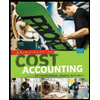
Concept explainers
Variance interpretation
Vanadium Audio Inc. is a small manufacturer of electronic musical instruments. The plant manager received the following variable factory
| Actual | Budgeted Variable Factory Overhead at Actual Production | Controllable Variance | |
| Supplies | $ 42,000 | $ 39,780 | S 2,220 U |
| Power and light | 52,500 | 50,900 | 1,600 U |
| Indirect factory wages | 39,100 | 30,600 | 8,500 U |
| Total | $133,600 | $121,280 | $12,320 U |
Actual units produced: 15.000 (90% of practical capacity)
The plant manager is not pleased with the $12,320 unfavorable variable factory overhead controllable variance and has come to discuss the matter with the controller. The following discussion occurred:
Plant Manager: I just received this factory report for the latest month of operation. I’m not very pleased with these figures. Before these numbers go to headquarters, you and I need to reach an understanding.
Controller: Go ahead. What’s the problem?
Plant Manager: What's the problem? Well, everything. Look at the variance. It’s too large. If I understand the accounting approach being used here, you are assuming that my costs are variable to the units produced. Thus, as the production volume declines, so should these costs. Well. I don’t believe these costs are variable at all. I think they are fixed costs. As a result when we operate below capacity, the costs really don’t go down. I’m being penalized for costs I have no control over. I need this report to be redone to reflect this fact. If anything, the difference between actual and budget is essentially a volume variance. Listen. I know that you’re a team player. You really need to reconsider your assumptions on this one.
If you were in the controller’s position, how would you respond to the plant manager?
Trending nowThis is a popular solution!

Chapter 23 Solutions
Bundle: Accounting, Loose-Leaf Version, 26th + LMS Integrated for CengageNOW, 2 terms Printed Access Card
- I need help solving this general accounting question with the proper methodology.arrow_forwardPlease explain the solution to this general accounting problem using the correct accounting principles.arrow_forwardI need help finding the accurate solution to this financial accounting problem with valid methods.arrow_forward
- Please explain the solution to this financial accounting problem with accurate explanations.arrow_forwardI am looking for the correct answer to this general accounting question with appropriate explanations.arrow_forwardPlease provide the answer to this general accounting question using the right approach.arrow_forward
 Managerial AccountingAccountingISBN:9781337912020Author:Carl Warren, Ph.d. Cma William B. TaylerPublisher:South-Western College Pub
Managerial AccountingAccountingISBN:9781337912020Author:Carl Warren, Ph.d. Cma William B. TaylerPublisher:South-Western College Pub Financial And Managerial AccountingAccountingISBN:9781337902663Author:WARREN, Carl S.Publisher:Cengage Learning,
Financial And Managerial AccountingAccountingISBN:9781337902663Author:WARREN, Carl S.Publisher:Cengage Learning, Principles of Cost AccountingAccountingISBN:9781305087408Author:Edward J. Vanderbeck, Maria R. MitchellPublisher:Cengage Learning
Principles of Cost AccountingAccountingISBN:9781305087408Author:Edward J. Vanderbeck, Maria R. MitchellPublisher:Cengage Learning- Principles of Accounting Volume 2AccountingISBN:9781947172609Author:OpenStaxPublisher:OpenStax College
 Managerial Accounting: The Cornerstone of Busines...AccountingISBN:9781337115773Author:Maryanne M. Mowen, Don R. Hansen, Dan L. HeitgerPublisher:Cengage Learning
Managerial Accounting: The Cornerstone of Busines...AccountingISBN:9781337115773Author:Maryanne M. Mowen, Don R. Hansen, Dan L. HeitgerPublisher:Cengage Learning Cornerstones of Cost Management (Cornerstones Ser...AccountingISBN:9781305970663Author:Don R. Hansen, Maryanne M. MowenPublisher:Cengage Learning
Cornerstones of Cost Management (Cornerstones Ser...AccountingISBN:9781305970663Author:Don R. Hansen, Maryanne M. MowenPublisher:Cengage Learning





